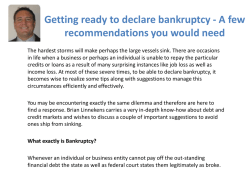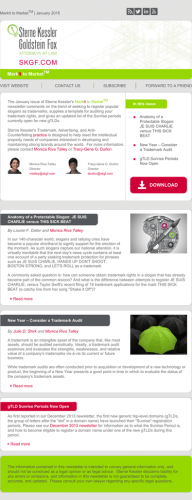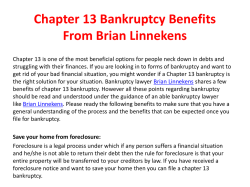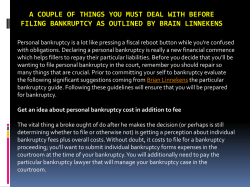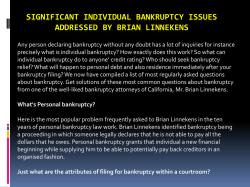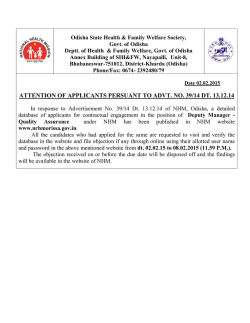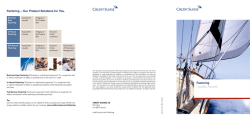
Crumbs and Trends in the Consideration of IP Licensees
The Essential Resource for Today’s Busy Insolvency Professional Feature By Bradley S. Friedman1 Cupcakes for Sale Crumbs and Trends in the Consideration of IP Licensees’ Rights O ver the past several years, a handful of decisions from both bankruptcy and appellate courts have obfuscated what otherwise had been considered a clear reading of how the Bankruptcy Code treats the rights of licensees of certain intellectual property (IP). A recent decision from the U.S. Bankruptcy Court for the District of New Jersey in In re Crumbs Bake Shop Inc. highlights trends on such major issues including, among others, whether a trademark licensee has rights under § 365(n) of the Bankruptcy Code to continue to use the licensed trademarks upon rejection by a debtor/licensor despite no reference to trademarks in the Code.2 Bradley S. Friedman Milbank Tweed Hadley & McCloy LLP New York Bradley Friedman is an associate with Milbank Tweed Hadley & McCloy LLP in New York and specializes in financial restructuring and distressed assets. Crumbs’ Business, Bankruptcy, the Sale and the Court’s Holdings Crumbs Bake Shop Inc. was one of the country’s largest and most recognizable brand name cupcakes retailers, operating retail stores that sold their cupcakes and other baked goods.3 Beginning in early 2014, Crumbs aggressively expanded its licensing program, which consisted of licensing its name and trade secrets to various retailers including BJ’s wholesale and Pelican Bay Specialty Gourmet.4 Around the same time, Crumbs received 1 The views expressed herein are of the author and not the views of Milbank Tweed Hadley & McCloy LLP. 2 In re Crumbs Bake Shop Inc., No. 14-242872014 Bankr. LEXIS 4568 (Bankr. D.N.J. Oct. 31, 2014). The opinion also includes two other significant holdings that are not the subject of this article, including the following: (i) A sale of the debtor’s assets pursuant to sections 363(b) and (f) neither trumps nor extinguishes the rights of third party licensees under section 365(n) in the absence of consent. The trademark licensee did not provide “implied consent” because the debtors failed to provide adequate notice in the sale motion that the sale would be free and clear of existing encumbrances. Even in the absence of such consent, section 363(f) does not override section 365(n) protections. (ii) The debtor is the only part[y] entitled to the collection of royalties generated as a result of licensees’ use of licensed intellectual property from the section 365(n) election (as opposed to the purchaser of the trademark). 3 First Day Affidavit ¶ 9. 4 Id. ¶ 13-15. The program involved Crumbs entering into a representation agreement with a third party to provide services to Crumbs, including finding licensees and providing related services, such as royalty collection. a secured loan of $5 million, which, at the time of filing, was held by Lemonis Fischer Acquisition Co. LLC (LFAC) with more than $5.5 million due and owing, and was set to mature on the day before the chapter 11 filing.5 Crumbs’ aggressive expansion, including the licensing program, coincided with the country’s “cupcake craze,” which resulted in increased competition, lower margins and, eventually, a liquidity crunch. As a result, the retail bakery closed its stores on July 7, 2014. Shortly thereafter, LFAC agreed to provide approximately $1.1 million in debtor-in-possession (DIP) financing and act as a stalking-horse bidder for substantially all of the company’s assets, and credit-bidding the entire amount of outstanding debt under the pre-petition and DIP loans.6 Crumbs filed its chapter 11 petition on July 11, 2014, and three days later filed a motion to approve the credit-bid asset-purchase agreement with LFAC and bidding procedures for an auction.7 Following an uneventful auction in late August, the bankruptcy court approved the sale to LFAC free and clear of any liens, claims, encumbrances and interests, including free of rights to use certain trademarks under certain license agreements. No licensees objected to the sale motion. The next day, Crumbs filed a motion to reject certain executory contracts, including several agreements licensing its trademarks and trade secrets to third parties (the “license agreements”). In objections to the rejection motion, Crumbs’ pre-petition third-party IP service provider and certain of the licensees under the license agreements asserted rights to continue to use the Crumbs trademarks and trade secrets pursuant to § 365(n). 5 In addition, Crumbs issued unsecured convertible notes and converted all accrued interest thereunder to common stock prior to the filing, resulting in about $9.3 million of outstanding unsecured debt as of the date of the chapter 11 petition. The debtor also had approximately $5 million in other unsecured trade claims. 6 Motion to Approve Sale, Docket Entry 22, Case No. 14-24287, U.S. Bankruptcy Court, District of New Jersey. 7 In re Crumbs at *4-*5. 66 Canal Center Plaza, Suite 600 • Alexandria, VA 22314 • (703) 739-0800 • Fax (703) 739-1060 • www.abi.org Left with nearly no assets as a result of the sale to LFAC, Crumbs withdrew the rejection motion with respect to the license agreements. Soon thereafter, LFAC filed a motion seeking clarification from the court that the sale order and purchase agreement resulted in the transfer of the copyrights to LFAC free and clear of the license agreements, and that the licensees had no § 365(n) rights against LFAC as a result of the licensees’ failure to object to the sale and the entry of the order approving the sale. The bankruptcy court concluded, among other things, that despite the explicit exclusion of the Lanham Act (the federal trademark statute) from the definition of “intellectual property” in the Bankruptcy Code, licensees of the rejected trademark licenses can utilize § 365(n) and continue to use the licensed trademarks after they are rejected. In other words, should the licensees elect to do so, LFAC’s purchase of the trademarks would be subject to the rights provided under the license agreements, as they existed just before the filing of the chapter 11 case. Section 365(n), Definition of “Intellectual Property” and Recent Circuit Court Cases Section 365(n) in General Section 365(n) gives the option to licensees of “intellectual property” to retain their rights under a license agreement, as such rights existed immediately before the commencement of the bankruptcy case notwithstanding the rejection of the agreement.8 The Bankruptcy Code defines “intellectual property” to include, among other things, patents, trade secrets and copyrights, often citing the particular federal law protecting such property. The definition neither includes nor references trademarks or the Lanham Act. Congress enacted § 365(n) following the Lubrizol decision by the Fourth Circuit Court of Appeals, which held that pursuant to § 365(g), the rejection of a license agreement to use certain of the debtor’s patents and trade secrets resulted in the loss of the licensee’s rights to continue to use such intellectual property, and all that remained were the licensee’s rights to non-specific performance remedies.9 Particularly, the Fourth Circuit held that § 365(g) results in a “‘statutory ‘breach’ ... and provides only a money-damages remedy for the non-bankrupt party ... and [a]llowing specific performance would obviously undercut the core purpose of rejection under section 365(a).”10 Recent Circuit Court Decisions For years, bankruptcy and appellate courts generally seemed to categorically exclude trademark licenses from “intellectual property” and deny § 365(n) rights to licensees. 11 The Crumbs opinion highlights two of the three circuit court decisions from the past four years, whereby some circuit court judges have shown willingness under 8 For a more detailed overview of § 365(n) and an overview of IP licenses and terminology, see Bradley S. Friedman, “Taking the Intellectual Out of Intellectual Property Licenses under Section 365 of the Bankruptcy Code,” Norton Journal of Bankruptcy Law and Practice, Vol. 20, No. 6 (2011). 9 Lubrizol Enters. v. Richmond Metal Finishers, 756 F.2d 1043, 1048 (4th Cir. 1985). Section 365(g) provides, in relevant part, that “the rejection of an executory contract ... of the debtor constitutes a breach of such contract.” 11 U.S.C. § 365(g). 10Id. at 1048. 11See, e.g., In re Gucci, 126 F.3d 380 (2d Cir. 1997); In re Dynamic Tooling Sys. Inc., 349 B.R. 847 (Bankr. D. Kan. 2006); In re Global Holdings Inc., 290 B.R. 507 (Bankr. D. Del. 2003); In re Centura Software Corp., 281 B.R. 660, 673-74 (Bankr. N.D. Cal. 2002); In re Blackstone Potato Chip Co., 109 B.R. 557 (Bankr. D.R.I. 1990). certain factual circumstances to provide trademark licensees with use rights notwithstanding the rejection of the license. 12 When considered together, these circuit court decisions seem to be gradually providing arguments as to why § 365( n)-like protections should be extended to trademark licensees. However, the Crumbs court has questionably taken the rationale of those circuit courts one significant step further. In 2010, the Third Circuit held in In re Exide Technologies that a perpetual, exclusive and royalty-free trademark license that was part of a larger, decade-old asset-purchase agreement pursuant to which the debtor had sold a certain business unit was not executory and, therefore, could not be rejected by the debtor.13 In other words, the trademark license continued to exist because the debtor could not reject the contract. In a concurring opinion, which the Crumbs court repeatedly cites, Hon. Thomas L. Ambro quoted a Senate report on § 365(n) that notes that trademark licenses were not included because of certain issues related to the various statutory requirements that were imputed to a trademark licensee, and therefore, “it was determined to postpone congressional action in this area and to allow the development of equitable treatment of this situation by bankruptcy courts.”14 While subtly referencing his belief that Lubrizol was wrongly decided, Judge Ambro concluded that the court should have used its “equitable powers to give [the debtor] a fresh start without stripping [the trademark licensee] of its fairly procured trademark rights,” as opposed to making the technical finding that the license, taken together with the asset-purchase agreement as single contract, was not executory.15 In 2012, the Seventh Circuit held in Sunbeam Products Manufacturing that the rejection of a trademark license, which was part of a supply agreement that related to the manufacturing and sale of electric fans by a third party, does not automatically extinguish the licensee’s right to use the intellectual property because § 365(g) deems rejection to be a breach, as opposed to a termination of both parties’ rights under the contract. In other words, the Seventh Circuit agreed with Judge Ambro, rejected the holding of Lubrizol and held that rejection results in a breach (as opposed to a recession or avoidance) of a contract and “merely frees the estate from the obligation to perform” and “has absolutely no effect upon the contract’s continued existence.”16 However, unlike Judge Ambro in Exide, the Seventh Circuit rejects the idea of addressing the issue of trademark licenses under § 365(n) on “equitable” grounds, explaining that “[r]ights depend ... on what the Code provides rather than on notions of equity.”17 In June 2014, the Eighth Circuit Court of Appeals in Interstate Bakeries, sitting en banc, reversed an Eighth Circuit panel decision from 2012 and held that a perpetual, royalty-free, assignable, transferable exclusive trademark license that was part of a nearly two-decadeold asset-purchase agreement was not executory, and 12Sunbeam Prods. Inc. v. Chi. Am. Mfg. LLC, 686 F.3d 372 (7th Cir. 2012); In re Interstate Bakeries Corp., 690 F.3d 1069, rev’d en banc, 751 F.3d 955 (8th Cir. 2014); In re Exide Techs., 607 F.3d 957 (3d Cir. 2010). 13In re Exide Techs., 607 F.3d at 963-64. 14Id. at 967-68 (citing S. Rep. No. 100-505, at 5, reprinted in 1988 U.S.C.C.A.N. at 3204) (emphasis added). 15Id. 16Sunbeam Prods. Inc. v. Chi. Am. Mfg. LLC, 686 F.3d at 377. 17Id. at 375. 66 Canal Center Plaza, Suite 600 • Alexandria, VA 22314 • (703) 739-0800 • Fax (703) 739-1060 • www.abi.org therefore could not be rejected by the debtor.18 With facts very similar to those before the Exide court (and referencing the Exide decision), and by holding that rejection of a license was not available to the debtor, the Eighth Circuit never discussed whether rejection of a trademarklicensing agreement terminates the licensee’s rights to use the trademark, and only referenced the circuit split on the issue.19 Nevertheless, the Interstate Bakeries decision, taken together with Exide and Sunbeam, demonstrates a willingness of appellate courts to find rationales for avoiding the harsh effects of the Lubrizol decision with respect to trademark licenses. The Crumbs Court Goes Much Further The Crumbs court espoused several rationales without selecting one as the basis of its holding that the licensees under the license agreements have the rights of any other “intellectual property”-holder under § 365(n). First, the court agreed with Judge Ambro’s concurring opinion and concluded that “Congress envisaged the Bankruptcy Courts as exercising discretion and equity on a case-bycase basis.” 20 However, in support of its conclusion, the court noted that there was no reason to augment the bankruptcy estate’s benefit from its ability to assume or reject executory agreements “at the expense of third parties and a licensing system [that] Congress sought to protect by means of preserving certain rights under section 365(n),” and it is “questionable that Congress intended to sacrifice the rights of licensees for the benefit of the lending community.”21 The court also stated that all purchasers come into a transaction “with eyes wide-open, after engaging in diligence, and can adjust their purchase price to account for such existing License Agreements,” and particularly that the court “does not conclude that [the licensees’] trademark rights should be vitiated completely to aid in LFAC’s recovery under its credit-bid.”22 Second, the court agreed with the Seventh Circuit in Sunbeam that rejection simply does not strip away a licensee’s rights to use a trademark because a breach does not terminate such rights outside of bankruptcy.23 In other words, the court rejected the Fourth Circuit’s holding in Lubrizol that the breach provided by § 365(g) as a result of rejection does not limit the licensee only to non-specific performance remedies under the contract (i.e., damages). Third, the court was motivated by the fact that legislation before Congress is pending, which “suggests that Congress is aware of the prejudice to trademark licensees from the approach espoused by LFAC, and is attempting to remedy the omission of ‘trademarks’ from its definition of ‘intellectual property.’”24 As a result, rather than merely resting on the “equitable” determination as suggested by Judge Ambro, the Crumbs court has thrown every tool available at LFAC and found that regardless of any argument to the contrary, a trademark license is protected by § 365(n) during a sale involving a credit-bid. Conclusion A few lessons can be inferred from the Crumbs decision and the Exide/Sunbeam/Interstate Bakeries line of cases. First, courts faced with IP-rich debtors have tools at their discretion to provide licensing rights for trademark licenses, notwithstanding attempts by the debtor to reject the license. There is a circuit split on the effects of Lubrizol. LFAC has appealed the Crumbs decision to the district court, and it is possible that the Third Circuit case law on the issue will be developed further. For the time being, debtors with valuable trademarks encumbered by third-party licensing rights might consider avoiding a bankruptcy filing in the Third, Eighth and Seventh Circuits. On the other hand, licensees might consider other protections, such as acquiring a security interest in the trademark, which would elevate them to securedcreditor status and potentially bring them to the negotiating table prior to a sale process or rejection. Second, throughout the decision (including on other related issues), the court accused Crumbs and LFAC of trying to hide the fact that the sale would be free of the license agreements. While not directly relevant to the § 365(n) and (g) analysis, the court was clearly skeptical of the timing and process of the sale and rejection (i.e., the sale was approved, then immediately following entry of the order, the debtor sought to reject licenses for intellectual property that it no longer owned). Similarly situated debtors might consider providing notice to licensees along with the notice of the sale that the following license agreements will be rejected. Third, purchasers of assets, including trademarks outside of bankruptcy, should consider having the purchase agreements and the license agreement integrated, making clear the amounts of the purchase price allocated to intellectual property, and choosing the law of a jurisdiction with favorable integrated-contract case law. abi Reprinted with permission from the ABI Journal, Vol. XXXIV, No. 2, February 2015. The American Bankruptcy Institute is a multi-disciplinary, nonpartisan organization devoted to bankruptcy issues. ABI has more than 12,000 members, representing all facets of the insolvency field. For more information, visit abi.org. 18In re Interstate Bakeries Corp., 751 F.3d 955, 963 (8th Cir. 2014). 19Id. at 964. 20Crumbs at *13. 21Id. at *12-13. 22Id. at *13. 23Id. at *14. 24Id. at *15. 66 Canal Center Plaza, Suite 600 • Alexandria, VA 22314 • (703) 739-0800 • Fax (703) 739-1060 • www.abi.org
© Copyright 2026
